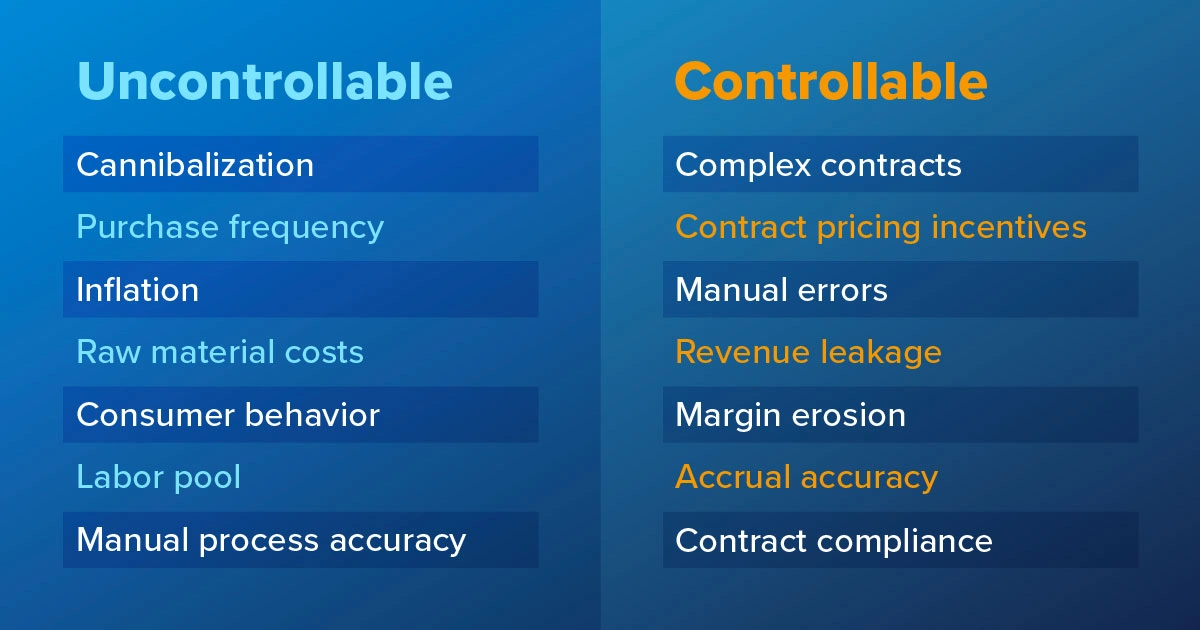
You can control contract pricing incentives to prevent revenue leakage and margin erosion
Saying Consumer Packaged Goods Manufacturers have faced a monumental amount of uncertainty and pressure over the last few months, is probably the understatement of the century. Maybe more so for those with a secondary product route to market or Foodservice/B2B. You are dealing with the added volatility related to the food away from home consumer and/or the uncertainty of how many or often, people are dining out plus adjustments to their restaurants of choice. In addition, consumers may be ordering differently for example, burgers instead of steaks and skipping appetizers or desserts.
CPG manufacturers selling products in the grocery store must contend with inflation and volatility and this is done by passing the cost on to the consumer in the form of a price increase or a reduction of promotional activity. Retail consumers will always need to purchase groceries and typically will not change their habits with the type of products they buy. However, consumers will trade down from a premium to an economical brand or buy fewer items per trip, adjusting their buying habits in response to economic pressures.
In B2B, there are 2 essential variables to understand:
- Cannibalization: this is based upon budget pressures or the “dining out” consumer who trades down to a “less expensive” menu option or choice of restaurant.
- Purchase frequency: this is about reducing the weekly frequency of dining out.
For a CPG manufacturer in the Foodservice B2B route to market, these are the 2 primary variables/downsides that can drive revenue leakage and margin erosion.
In the retail route to market or B2C, you need to understand your price elasticity at shelf and the negotiated contract purchase price when passing along a price increase or trade spend reduction. In the Foodservice B2B route to market, you have a similar dilemma and variables, with one influencing the other. As the retail consumer’s budget is more impacted by inflation at the grocery store, typically their food away from home or “dining out” behavior changes. More discouraging for manufacturers, these are the variables that can’t be controlled.
Preventing revenue leakage
A conversation that I have often with CPG manufacturers, seeking a solution to prevent revenue leakage and margin erosion related to the above-described variables, is based upon trying to control the uncontrollable.
My 2 questions to them are always:
- Why are you trying to control what is uncontrollable?
- Have you looked at controlling and safeguarding what you can control?
The answer I typically receive is “no” to both questions.
With a focus on those manufacturers who manage a Foodservice B2B route to market, we can help identify one of the main areas for revenue leakage and margin erosion. When selling through the Foodservice B2B route to market there is a predominance of negotiated contract pricing incentives such as volume incentives with purchase period conditions. Margin erosion is typically the result of a lack of controls when negotiating a contract price and allowing the negotiated contract price to fall below the “dead net” margin threshold. This has been exacerbated most recently by the volatility and unprecedented rise in raw material costs.
Historically, CPG manufacturers could rely on steady raw material cost components to produce their products. As such, there was no emphasis on stringent control of dead net margins. The lack of emphasis was more often related to a technology constraint of their internal IT ecosystem. CPG manufacturers typically use purpose-built software applications which are often not connected or able to run in real time. Or maybe a less technical constraint was that they weren’t sure what the “dead net” margin threshold for a product would be.
Managing complex contracts
As the discovery discussion related to margin erosion continues, we begin to identify the cause of revenue leakage. Often in the Foodservice B2B route to market it’s about contract pricing incentives. In many cases, these contracts can contain multiple overlapping incentive contract terms which creates complexity. These contract incentives can require the CPG’s customer to purchase volume in tiers over a defined period. In short, “If you buy 1,000 cases in the first month at X price, I will sell you the next 2,000 at the better X price,” which requires the application to track purchase orders or invoiced sales to ensure that the customer has met the contract terms and deserves the incented contract price. Revenue leakage occurs when there is no validation that the contract terms have been met and the customer receives a contract price that they don’t deserve.
During these discussions, the manufacturer begins to realize that these are areas that they can control and need to reprioritize. This can lead to looking at processes that have historically been deemphasized due to complacency but in reality, need to be reevaluated. So, it’s a good idea to ask yourself, “Am I trying to control something I can’t?” “How do I control what’s controllable?” The best place to start is to look into the areas that impact margin or can create revenue leakage and begin to understand how they can be controlled.
Get the latest news, updates, and exclusive insights from Vistex delivered straight to your inbox. Don’t miss out—opt in now and be the first to know!

